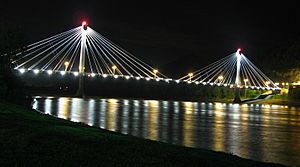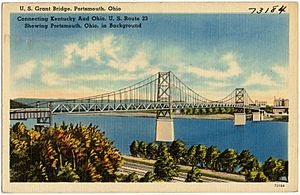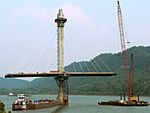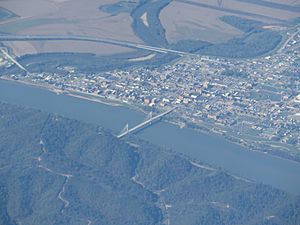U.S. Grant Bridge facts for kids
Quick facts for kids U.S. Grant Bridge (current) |
|
|---|---|

Current U.S. Grant Bridge carrying US 23 over the Ohio River.
|
|
| Coordinates | 38°43′39″N 82°59′50″W / 38.72750°N 82.99722°W |
| Carries | 2 lanes of |
| Crosses | Ohio River |
| Locale | Portsmouth, Ohio and South Portsmouth, Kentucky |
| Maintained by | Ohio Department of Transportation |
| Characteristics | |
| Design | Cable-stayed bridge |
| Total length | 657 m (2155 ft.) |
| Longest span | 267 m (875 ft.) |
| History | |
| Opened | October 16, 2006 at a cost of more than $28,434,495 |
The U.S. Grant Bridge is a name used for two bridges that connect Portsmouth, Ohio and South Portsmouth, Kentucky. These bridges carry U.S. Route 23 traffic across the Ohio River. The first bridge was a suspension bridge that closed and was taken down in 2001. A new cable-stayed bridge replaced it, opening on October 16, 2006.
Contents
Discover the New U.S. Grant Bridge
Contracts for building the new U.S. Grant Bridge began in the spring of 2001. The builders hoped to finish the bridge by June 2004. However, the project faced several challenges.
Bad weather caused delays. There was also unusual flooding of the Ohio River. A floating construction barge, which held a crane, partly sank. These problems pushed the completion date back. The new bridge finally opened on October 16, 2006.
Explore the Original U.S. Grant Bridge
| U.S. Grant Bridge | |
|---|---|

1930s postcard
|
|
| Coordinates | 38°43′50″N 82°59′49″W / 38.73056°N 82.99694°W |
|
General U.S. Grant Bridge
|
|
| Location | Ohio R.-Chillicothe and Second St., South Portsmouth, Kentucky |
| Built | 1927 |
| Architect | Robinson and Steinman; et al. |
| Architectural style | Cable suspension bridge |
| NRHP reference No. | 01000560 |
| Added to NRHP | May 31, 2001 |
| Carries | 2 lanes of |
| Crosses | Ohio River |
| Locale | Portsmouth, Ohio and South Portsmouth, Kentucky |
| Maintained by | Ohio Department of Transportation |
| Characteristics | |
| Design | Suspension bridge |
| History | |
| Opened | 1927 |
| Closed | 2001 |
| Statistics | |
| Toll | tolls dropped in 1974 |
The first U.S. Grant Bridge was a suspension bridge. It opened for traffic in 1927. At first, people had to pay a toll to cross it. In 1974, the Ohio Department of Transportation (ODOT) bought the bridge. They then removed the tolls, making it free to cross.
Bridge Repairs and New Connections
In 1978, an inspection showed serious damage to the bridge's cables. The U.S. Grant Bridge had to close for repairs. It reopened about 18 months later in 1979. To help with traffic, new bridges were planned. The Carl Perkins Bridge opened in 1988. The Jesse Stuart Memorial Bridge opened in 1984. These bridges gave more ways to cross the Ohio River.
Deciding the Bridge's Future
By 1992, ODOT began studying what to do with the old bridge. They wanted to know if they should keep fixing it or build a brand new one. From 1977 to 1996, ODOT spent $9 million on repairs. The study found that fixing the bridge would only make it last another 20 years. This would cost almost $30 million.
It was decided that constantly repairing the old bridge was too expensive. Building a new bridge would be cheaper in the long run. The old bridge kept getting older and closed again for repairs in 1994.
A Historic Landmark
On May 31, 2001, the original bridge was added to the National Register of Historic Places. It was called the General U.S. Grant Bridge. It was important because it was the first private toll bridge across the Ohio River in that area. It helped connect southern Ohio and northeastern Kentucky.
The bridge was also special because of its design. It was designed by David B. Steinman, a famous bridge designer. His firm, Robinson and Steinman, was well-known for building suspension bridges. The U.S. Grant Bridge was one of the first American suspension bridges with a special type of stiffening truss and unique towers.
On July 3, 2001, the original suspension bridge closed for good. The entire structure was taken down within a few months.





